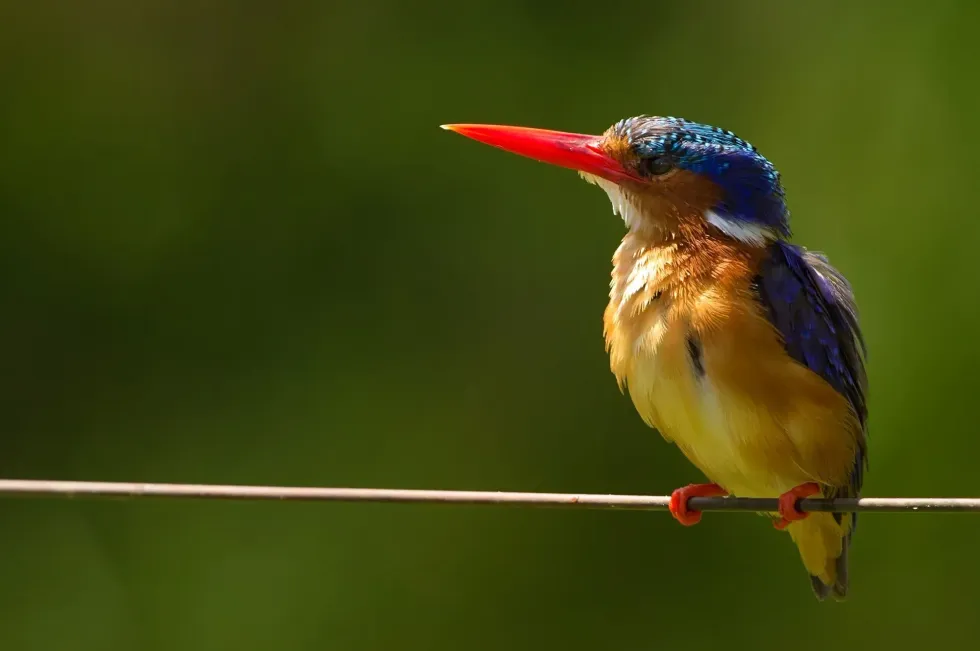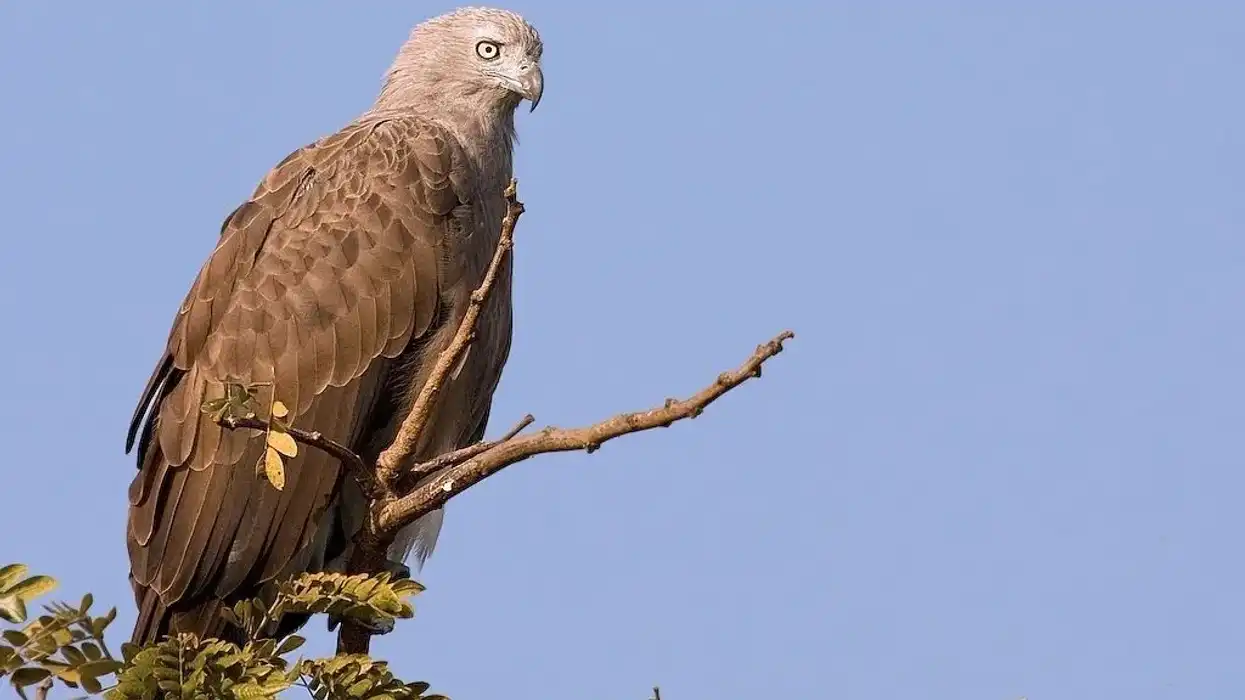Beautiful with a gem-like back and blue coloring, these South African birds are excellent fish hunters. Closely related to the Malagasy kingfisher, malachite kingfishers often sit on perches with their body pointed downwards.
This bird drops suddenly to catch their prey from the water. They are also called the river kingfisher because of their habit of preferring aquatic vegetation near rivers or other water bodies as their habitat.
They are monogamous and are known to form long-lasting bonds. The breeding season mostly depends on whenever there is a high fish availability.
About three to six eggs are laid and both parents are responsible for taking care of the young. The scientific names of the malachite kingfisher, Alcedo cristata and Corythornis cristatus, imply them having a short crest on their head.
There are many interesting facts about these birds and we have gathered them all here. Please read on to learn more.
If you like reading fun articles about birds, please check out our similar ones crested kingfisher and blue-eared kingfisher.
Malachite Kingfisher Interesting Facts
What type of animal is a malachite kingfisher?
Malachite kingfishers are a type of river kingfishers that are native to the southern region of the Sahara Desert in Africa. The scientific name of the malachite kingfisher, Corythornis refers to them having a short crest or plume of feathers on their head.
What class of animal does a malachite kingfisher belong to?
Like all birds in existence, these birds from Sub-Saharan Africa belong to the class of Aves. They produce eggs instead of giving birth to live young. Found around dense vegetation near slow-moving water or ponds, malachite kingfishers are known to feed on aquatic insects and small fish.
How many malachite kingfisher are there in the world?
It is hard to say just how many of these birds are there in Sub Saharan Africa, however, they are listed as a species of Least Concern in the IUCN Red List of Threatened Species. It can be assumed that malachite kingfishers are not under any immediate threat of extinction.
Where does a malachite kingfisher live?
The malachite kingfisher is often found around swamps, lakes, mangrove forests, and other wet places in South Africa, Senegal, Ethiopia, Sub-Saharan Africa, and Eritrea.
What is a malachite kingfisher's habitat?
This African bird prefers wet places as its habitat, which is why they nest around aquatic vegetation, swamps, lakes, ponds, marshes, dams, mangrove forests, drainage ditches, and sometimes even on a sandy bank. They spend most of their time sitting on a perch over water bodies to look for prey.
After catching their prey, they return to their perch once again.
Who do malachite kingfisher live with?
Malachite kingfishers are known to be diurnal which means they are active during the day. These birds are also mostly solitary and highly territorial.
This is why they are not known for interacting with other members of their own kind except for in the breeding season. Adults of this small kingfisher bird from South Africa are mostly residential to their nest around the aquatic vegetation of river or water bodies.
The young birds however are known for their tendencies of flying away from their nesting chamber.
How long does a malachite kingfisher live?
For such a small creature, this African river bird has a long lifespan. On average, they are known to live for as long as seven years, and in some cases even more than that.
Adult birds spend most of their time sitting on a perch that is low over water bodies that helps them to locate prey easily and return to their perch once the fish or the aquatic insects are caught.
How do they reproduce?
The malachite kingfisher is known to be monogamous and they make long-lasting bonds. The breeding season varies from range to range but generally occurs when the fish are highly available.
Courtship displays often occur in these kingfishers and usually consist of aerial chases and mating calls. Both adults are responsible for digging out a few nests but usually, only one is completed and used.
About three to six eggs are laid, with a one-day gap and both parents incubate the eggs which lasts for about 14-16 days. The chicks are born vulnerable and blind and fledging happens at about 22-25 days.
They can hunt for prey on their own a week after fledging. Adult birds excavate the young from the nest at about 36-40 days when they are fully independent.
What is their conservation status?
The malachite kingfisher, just like the belted kingfisher, is listed as a species of Least Concern in the IUCN Red List of Threatened Species. It can be assumed that there is no immediate threat of extinction looming over this small kingfisher bird.
Malachite Kingfisher Fun Facts
What do malachite kingfishers look like?
Malachite kingfishers are a small bird species with beautiful gem-like colors. The upper side of their body has a vibrant blue plumage, with the underside being a reddish-orange.
There is a short crest on their black and blue-colored head and there are white patches on the throat as well as on their neck sides. Both males and females look similar, as do the young, down to the white patches on the throat. However, the coloring of the young is a bit duller than the adults.
How cute are they?
The malachite kingfisher (Corythornis cristatus) is a beautiful bird from South Africa. With their blue-black body and short crest, these fish hunters look regal whether they are flying or sitting on perches.
How do they communicate?
Like all birds, the African kingfisher malachite communicates through their unique calls and body gestures. During the breeding season, they use these calls and aerial displays to attract potential mates.
How big is a malachite kingfisher?
The malachite kingfisher (Corythornis cristatus) is a small bird, only growing up to about 3.4-5.1 in (10-13 cm) in length as adults. They are about the same size as their closely related species, the Malagasy kingfisher which is also 3.4-5.1 in (10-13 cm) long.
How fast can a malachite kingfisher fly?
For a small bird, the kingfisher malachite can fly quite fast. Their top speed is about 25 mph (40 kph).
How much does a malachite kingfisher weigh?
The malachite kingfisher (Corythornis cristatus) is a small bird and they are relatively light in terms of weight. On average, they only weigh about 0.02-0.04 lb (12-19 g).
What are the male and female names of the species?
The malachite kingfisher (Corythornis cristatus) has no gender-specific names. They are just called a male malachite kingfisher or a female malachite kingfisher. Alcedo cristata is another scientific name for them.
What would you call a baby malachite kingfisher?
The babies of the malachite kingfisher (Alcedo cristata) are called chicks. About three to six eggs are laid with a one day gap and both parents are responsible for incubation. The white eggs hatch after an incubation period of 14-16 days and the young leave the nest at about 36-40 days after being born.
What do they eat?
This malachite kingfisher (Corythornis cristatus) bird from South Africa is carnivorous. It often sits on a perch close to the water with its body pointed downwards and drops suddenly to the water surface to catch fish, insects, crabs, frogs, prawns as well as insect larvae.
If the prey is big, it would beat it on a branch first before swallowing it whole. This bird is always found around rivers, moving water, or ponds around South Africa, earning them the name of river kingfishers.
Are they dangerous?
The malachite kingfisher is a small bird. These fish hunters possess no danger to you even if they become aggressive.
Would they make a good pet?
Even though the malachite kingfisher is a small bird, they do not make good pets. Mostly because these wild birds need water bodies as a habitat to survive along with lots of space to fly around.
Did you know...
The calls of kingfisher birds are not vocal, rather they make these sounds nasally.
What is special about kingfisher bird?
All kingfishers, including the malachite kingfisher, are known for their visual prowess. They can even look into the water clearly and their sight makes their prey seem closer than they are, which most birds can not do.
How many eggs do malachite kingfisher lay?
The malachite kingfisher (Alcedo cristata) is a small bird, only growing about 3.4-5.1 in (10-13 cm) in length, and they lay about three to six eggs on average.
Here at Kidadl, we have carefully created lots of interesting family-friendly animal facts for everyone to discover! For more relatable content, check out these common pochard facts and magpie duck facts for kids.
You can even occupy yourself at home by coloring in one of our free printable malachite kingfisher coloring pages.









